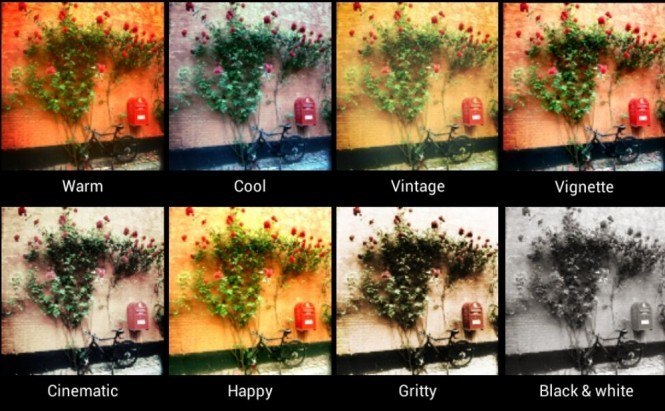 There is More to It than Instagram
There is More to It than Instagram
People tend to think that there are certain phenomena in our life that will never cease to be enormously popular. These are things that we use every day, and what matters here is that we even can't imagine how we used to live without them. What we're often missing is that actually as times change, these things undergo change as well.
Let's get straight to the point: Instagram is one of the trendiest apps - and social networks - these days. This ubiquitous application enables users to enhance their images by applying a variety of filters to them (to be precise, you can choose from 18 effects in total). Then you can resize your pictures and after that you can share the resulting image with your friends.
But there's of course a fly in the ointment. The seeming diversity of features is actually rather limited: each new option needs to be installed or, even worse, you may have to pay for it. And even though you may be trying to expand your Instagram into an all-in-one kit for your photos, even after you install everything possible, you can still hardly call Instagram an independent and full-fledged image editor.
Recently, two giant companies - Twitter and Google - made an attempt to shift Instagram and have a bite of its popularity. Right now it's hard to judge whether they have managed to overthrow Instagram or not, but I can at least try to give you an overview of what they offer and let you decide if they can turn out to be viable alternatives.
Twitter has launched its own library of filters for its Android and iPhone applications. Basically, now its users can easily post and refine pictures right from their Twitter app.
To achieve this, Twitter welcomed Aviary to its family, in the sense that it is Aviary that powers all the filters and effects. Let me give you a more detailed look into the program: the application allows you to choose from 8 filters ranging from black & white to vintage. Then you can preview how each of them will transform your image. After that you can apply a frame or use the auto-enhance feature. That's basically all the editing work that you're expected to do.
Frankly speaking, the application looks rough around the edges. The number of filters doesn't impress; and the features, to put it mildly, are quite basic. It seems that Twitter's main concern was to launch the app at all costs as soon as possible, without paying much attention to its capabilities. I strongly believe that Aviary should do much more work on the app for Twitter users to consider scrapping their cherished Instagram filters.
Google, in its turn, has introduced a gorgeous version of Snapseed, which is now available to both Android and iPhone users for free (by the way, the iOS version of Snapseed used to cost $4.99 until the Android release). In fact, the application is something most users could only dream of to this point. Seriously, Nik Software did a great job: the app looks very sophisticated and is very potent, but the interface is still pleasing to the eye and very elegant.
The application offers you basic adjustments like color tuning, straightening, and cropping. Then, after you're done with the basic editing, you can start applying different filters: for instance, drama, grunge, black & white, and vintage - but once you're inside a filter you'll find an even bigger diversity of options to choose from, like intensity, saturation, etc. Moreover, you can combine filters and effects, which allows for an infinite number of editing options and lets you make your pictures into something really terrific. And in addition to that, you can set control points, which let you enhance specific areas of your pictures rather then entire images. Finally, you can easily share your resulting images via Google+ or other services.
So, now that you have an overview of the apps that can edit and share your images, you can see that each of them has its own advantages and disadvantages. Ultimately, your choice will depend on what you are looking for; i.e. if you only need a simple and quick editor, then Twitter's library or Instagram will definitely be enough, but for those who are willing to have more options and more control over editing features, Snapseed is the best choice.







One of the first camera apps to come out for Android phones, and I've been using it ever since. Definitely has the most potential at taking the best photo and is very "sophisticated"--considered a professional camera phone app.
It turned off some people when it first came out because it wasn't user friendly at taking pics, as I had to toy around with it a while. But it's quite different now compared to how it was, as in definitely more user friendly at taking pics. Oh, nothing beats its filters. You actually have to explore and enjoy the infinite ways to use all of them, unlike Instagram which I took note of when it first came out, but am still in disbelief at how this pitiful camera app is the one that took off. I only give it credit for its great social networking features, which I'd like to see combined with an actual worthy photo app
Since Snapsheed is free, I'll check it out as it at least seems better then Instagram. More curious and hopeful of its social networking features, if it really has any. Otherwise, I'll stick to just uploading my pics taken with Vignette to Twitpic, which I'm completely fine with and just started recently doing on Twitter.
I've had it since it first came out a few years ago, in which it was initially anything but user friendly for taking pics, which drew a lot of people away. Many, whether they liked the actual camera or not, kept it for the amazing abundance of filters. I simply just toyed around with it for a while until I got the feel for it, because it's considered a professional camera app for a smartphone.
I'm not a photography major/minor yet, and actually never even had my own camera before, but once I saw how this camera app could take potentially a better picture of the same stationary object far better then the stock app, or any other for that matter I no doubt stuck with it. Several of the hundreds of pictures taken on my 5mp Droid, I used for my portfolio along with my writings for entrance into The Art Institute for a B.A. in Advertising and a Certificate in Photography. It's pricey, with a 40% acceptance rate, but they were the ones who sought me out. The photography professors were stunned by the high resolution and clarity created with only a 5mp Android phone, along with the very precise and fitting choice of filters I used for some of the pics as well.
I now have the Droid 4, which is 8mp. And even better is that Vignette has really tweaked and perfected itself over only around a dozen updates since it came out. Now, it's also what I'd consider user friendly at taking pics, with so many filters and editing options.
Vignette, it's worth your $5!